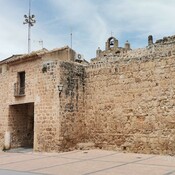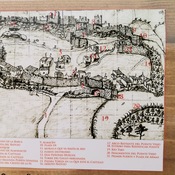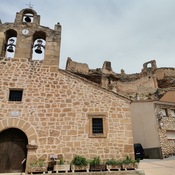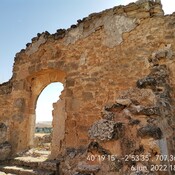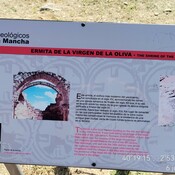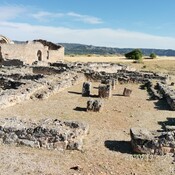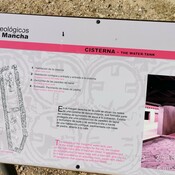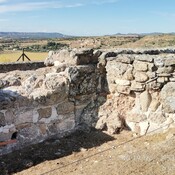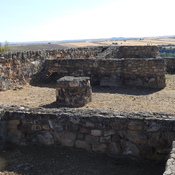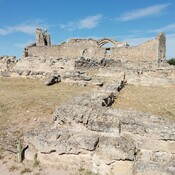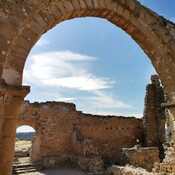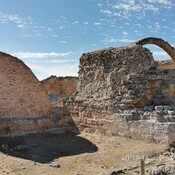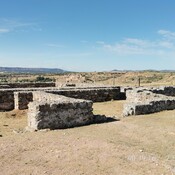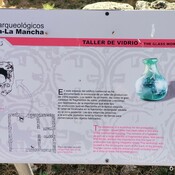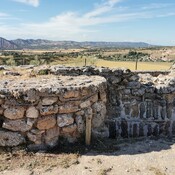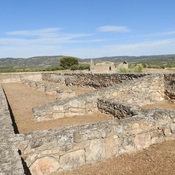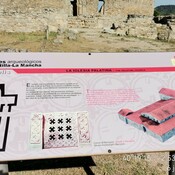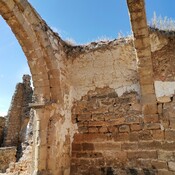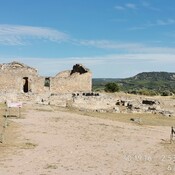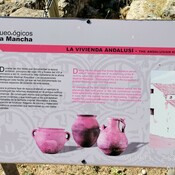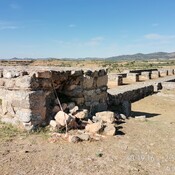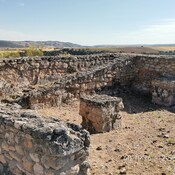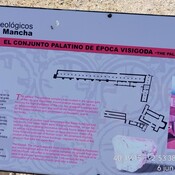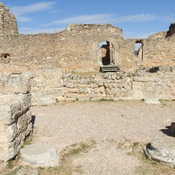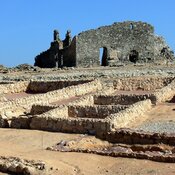Es gibt noch keine deutschsprachige Anmerkungen. Präsentiert wirden Anmerkungen auf English.
https://www.herreracasado.com/2015/07/10/el-castillo-de-zorita-de-los-canes/
https://www.castillosdeguadalajara.es/castillo-de-zorita/
Su importancia va ligada al valor estratégico que esta localidad tuvo en la Edad Media, ya que en esta pequeña población de la Alcarria se estableció la orden de Calatrava tras la batalla de Alarcos, perdida por los cristianos bajo el mando de Alfonso VIII en 1195, ante los almohades; hay que señalar que Zorita y su fortaleza pertenecían a esta orden desde que en 1174 se la entregara el rey Alfonso VIII; el mismo rey que en 1180 le otorgase fuero. Asimismo, Zorita fue cabeza de la denominada como Encomienda de Zorita. En el siglo XVI pasó a manos de la corona y en 1565, Felipe II vendía esta villa a Ruy Gómez de Silva y a su mujer, la Princesa de Éboli. Por entonces el castillo presentaba ya signos manifiestos de ruina, que se acrecentaron en los siglos siguientes.
El origen de este castillo se remonta a la conquista árabe de este territorio, aunque hay vestigios de una construcción anterior visigoda. Comenzó su construcción a finales del siglo IX, siendo emir de Córdoba Mohamed I. De la época árabe se conservan restos de murallas, en las que aparece su característica manera de construir de a soga y a tizón, varias torres y una de sus actuales puertas de acceso, la Puerta de Hierro, que conserva su arco de herradura. Tras su conquista, a finales del siglo XI, sufrió diversas ampliaciones, especialmente, por los caballeros calatravos, como la construcción de un gran recinto amurallado exterior que rodeaba al pueblo, y una serie de modificaciones que se prolongaron hasta el siglo XVI, de ahí que nos encontremos elementos pertenecientes al románico (su iglesia), al gótico (sus arcos ojivales) y al renacimiento (bastión defensivo del siglo XVI).
El recinto del castillo se expande a lo largo de un encrespado e irregular cerro, presentando un aspecto, todavía hoy, de inexpugnable fortaleza, que conserva varias de sus antiguas puertas que lo conectaban con la población y sus barrios. El acceso actual y por el que se entra al castillo tiene lugar por una puerta de esbelto arco ojival, gótico, que tapa otro de herradura, a la que se llega subiendo una escarpada y empinada cuesta, sobre ella aún se conserva una ventana con arco de medio punto. Otro lugar de acceso es a través del valle del arroyo Bodujo, atravesando la puerta ojival de la torre albarrana, construida por Rui Díaz en 1280; en este lugar se encontraba un puente levadizo que permitía cruzar sin dificultad el amplio foso que daba acceso a la fortaleza.
Este se encontraba dividido en dos zonas, una religiosa y otra militar preparándose, como ya se pueden imaginar, para las dos actividades más importantes a las que en esos momentos se dedicaba el hombre: a orar y a guerrear. Como principales elementos arquitectónicos de su interior nos encontramos, en la zona religiosa, con la iglesia románica del Priorato de San Benito, los enterramientos de caballeros calatravos y el corral de los condes. En el resto del reciento destacan diversas construcciones, algunas de ellas derruidas como un aljibe, la Sala del Moro, el bastión defensivo denominado como Torre del Espolón, la barbacana, el patio de armas, etc.
---
Its importance is linked to the strategic value that this town had in the Middle Ages, since in this small town of the Alcarria the order of Calatrava was established after the battle of Alarcos, lost by the Christians under the command of Alfonso VIII in 1195, before the Almohads; It should be noted that Zorita and her fortress belonged to this order since King Alfonso VIII handed it over to them in 1174; the same king who in 1180 granted him jurisdiction. Likewise, Zorita was head of the so-called Encomienda de Zorita. In the 16th century it passed into the hands of the crown and in 1565, Felipe II sold this town to Ruy Gómez de Silva and his wife, the Princess of Éboli. At that time the castle already showed obvious signs of ruin, which increased in the following centuries.
The origin of this castle dates back to the Arab conquest of this territory, although there are traces of a previous Visigoth construction. Its construction began at the end of the 9th century, when Mohamed I was the emir of Córdoba. Remains of walls remain from the Arab period, in which its characteristic way of building with rope and firebrand appears, several towers and one of its current gates. access, the Iron Gate, which retains its horseshoe arch. After its conquest, at the end of the 11th century, it underwent various extensions, especially by the Calatravian knights, such as the construction of a large exterior walled enclosure that surrounded the town, and a series of modifications that lasted until the 16th century, from there that we find elements belonging to the Romanesque (its church), the Gothic (its pointed arches) and the Renaissance (defensive bastion of the 16th century).
The castle enclosure expands along a rough and irregular hill, presenting, even today, the appearance of an impregnable fortress, which preserves several of its old gates that connected it with the town and its neighbourhoods. The current access and through which one enters the castle takes place through a door with a slender pointed arch, Gothic, which covers another with a horseshoe, which is reached by climbing a steep and steep slope, on it there is still a window with an arch semicircular. Another place of access is through the valley of the Bodujo stream, through the ogival door of the albarrana tower, built by Rui Díaz in 1280; In this place there was a drawbridge that allowed to cross without difficulty the wide moat that gave access to the fortress.
This was divided into two zones, one religious and the other military, preparing, as you can imagine, for the two most important activities that man dedicated himself to at that time: praying and fighting. As main architectural elements of its interior we find, in the religious area, the Romanesque church of the Priory of San Benito, the burials of Calatrava knights and the corral of the counts. In the rest of the enclosure, various constructions stand out, some of them demolished, such as a cistern, the Sala del Moro, the defensive bastion known as Torre del Espolón, the barbican, the parade ground, etc.
---
Son importance est liée à la valeur stratégique que cette ville avait au Moyen Âge, puisque dans cette petite ville de l'Alcarria l'ordre de Calatrava a été établi après la bataille d'Alarcos, perdue par les chrétiens sous le commandement d'Alphonse VIII en 1195, avant les Almohades ; Il est à noter que Zorita et sa forteresse appartenaient à cet ordre depuis que le roi Alphonse VIII le leur a remis en 1174 ; le même roi qui en 1180 lui a accordé la juridiction. De même, Zorita était à la tête de la soi-disant Encomienda de Zorita. Au XVIe siècle, elle passa aux mains de la couronne et en 1565, Felipe II vendit cette villa à Ruy Gómez de Silva et à son épouse, la princesse d'Éboli. A cette époque, le château présentait déjà des signes évidents de ruine, qui s'accentuèrent au cours des siècles suivants.
L'origine de ce château remonte à la conquête arabe de ce territoire, bien qu'il y ait des traces d'une construction wisigothe antérieure. Sa construction a commencé à la fin du IXe siècle, lorsque Mohamed I était l'émir de Cordoue.Il reste des vestiges de murs de la période arabe, dans lesquels apparaît sa façon caractéristique de construire avec des cordes et des tisons, plusieurs tours et une de ses portes actuelles. .accès, la Porte de Fer, qui conserve son arc outrepassé. Après sa conquête, à la fin du XIe siècle, elle subit diverses extensions, notamment par les chevaliers calatraviens, comme la construction d'une grande enceinte fortifiée extérieure qui entourait la ville, et une série de modifications qui dura jusqu'au XVIe siècle, de là que l'on retrouve des éléments romans (son église), gothiques (ses arcs brisés) et Renaissance (bastion défensif du XVIe siècle).
L'enceinte du château s'étend le long d'une colline rugueuse et irrégulière, présentant, encore aujourd'hui, l'apparence d'une forteresse imprenable, qui conserve plusieurs de ses anciennes portes qui la reliaient à la ville et à ses environs. L'accès actuel et par lequel on entre dans le château se fait par une porte avec un arc en ogive gothique élancé, qui en recouvre une autre avec un fer à cheval, auquel on accède en gravissant une pente raide et raide, il y a encore une fenêtre avec un arc semi-circulaire. Un autre point d'accès se fait par la vallée du ruisseau Bodujo, par la porte ogivale de la tour albarrana, construite par Rui Díaz en 1280 ; A cet endroit se trouvait un pont-levis qui permettait de franchir sans difficulté le large fossé qui donnait accès à la forteresse.
Celui-ci était divisé en deux zones, l'une religieuse et l'autre militaire, préparant, comme vous pouvez l'imaginer, aux deux activités les plus importantes auxquelles l'homme se consacrait à cette époque : la prière et le combat. Comme principaux éléments architecturaux de son intérieur, nous trouvons, dans la zone religieuse, l'église romane du Prieuré de San Benito, les sépultures des chevaliers Calatravo et le corral des comtes. Dans le reste de l'enceinte, diverses constructions se distinguent, certaines d'entre elles démolies, comme une citerne, la Sala del Moro, le bastion défensif connu sous le nom de Torre del Espolón, la barbacane, la place d'armes, etc.
---
Его важность связана со стратегическим значением, которое этот город имел в Средние века, поскольку в этом маленьком городке Алькаррии после битвы при Аларкосе, проигранной христианами под командованием Альфонсо VIII в 1195 году, был основан орден Калатравы. до Альмохадов; Следует отметить, что Зорита и ее крепость принадлежали этому ордену с тех пор, как король Альфонсо VIII передал их им в 1174 году; тот же король, который в 1180 году предоставил ему юрисдикцию. Точно так же Зорита был главой так называемой Encomienda de Zorita. В 16 веке она перешла в руки короны, а в 1565 году Фелипе II продал эту виллу Рую Гомесу де Сильве и его жене, принцессе Эболи. В то время в замке уже были явные признаки разрухи, которые в последующие века усилились.
Происхождение этого замка восходит к арабскому завоеванию этой территории, хотя есть следы предыдущей постройки вестготов. Его строительство началось в конце 9 века, когда эмиром Кордовы был Мухаммед I. Остатки стен сохранились с арабского периода, в котором проявляется его характерный способ строительства с веревкой и головней, несколько башен и одни из нынешних ворот. , доступ, Железные ворота, которые сохраняют свою подковообразную арку. После его завоевания, в конце 11 века, он претерпел различные расширения, особенно калатравскими рыцарями, такие как строительство большого ограждения с внешней стеной, окружавшее город, и ряд модификаций, которые продолжались до 16 века. оттуда мы находим элементы романского стиля (его церковь), готики (его стрельчатые арки) и ренессанса (оборонительный бастион 16 века).
Замковая ограда простирается вдоль неровного и неровного холма и даже сегодня представляет собой неприступную крепость, сохранившую несколько старых ворот, соединявших ее с городом и его окрестностями. Текущий доступ и через который вход в замок происходит через дверь со стройной готической стрельчатой аркой, которая закрывает другую подковой, до которой можно добраться, поднявшись по крутому и крутому склону, на ней еще есть окно с аркой полукруглый. Еще одно место доступа - через долину ручья Бодухо, через стрельчатую дверь башни альбаррана, построенной Руи Диасом в 1280 году; В этом месте находился разводной мост, позволявший без труда перейти широкий ров, дававший доступ к крепости.
Он был разделен на две зоны, одну религиозную и другую военную, готовясь, как вы можете себе представить, к двум самым важным занятиям, которым человек посвящал себя в то время: молитве и борьбе. В качестве основных архитектурных элементов его интерьера мы находим в религиозной части романскую церковь монастыря Сан-Бенито, захоронения рыцарей Калатраво и загон графов. В остальной части ограды выделяются различные постройки, некоторые из них разрушены, такие как цистерна, Сала-дель-Моро, оборонительный бастион, известный как Торре-дель-Эсполон, барбакан, плац и т. д.
https://www.herreracasado.com/2015/07/10/el-castillo-de-zorita-de-los-canes/
https://www.castillosdeguadalajara.es/castillo-de-zorita/
Su importancia va ligada al valor estratégico que esta localidad tuvo en la Edad Media, ya que en esta pequeña población de la Alcarria se estableció la orden de Calatrava tras la batalla de Alarcos, perdida por los cristianos bajo el mando de Alfonso VIII en 1195, ante los almohades; hay que señalar que Zorita y su fortaleza pertenecían a esta orden desde que en 1174 se la entregara el rey Alfonso VIII; el mismo rey que en 1180 le otorgase fuero. Asimismo, Zorita fue cabeza de la denominada como Encomienda de Zorita. En el siglo XVI pasó a manos de la corona y en 1565, Felipe II vendía esta villa a Ruy Gómez de Silva y a su mujer, la Princesa de Éboli. Por entonces el castillo presentaba ya signos manifiestos de ruina, que se acrecentaron en los siglos siguientes.
El origen de este castillo se remonta a la conquista árabe de este territorio, aunque hay vestigios de una construcción anterior visigoda. Comenzó su construcción a finales del siglo IX, siendo emir de Córdoba Mohamed I. De la época árabe se conservan restos de murallas, en las que aparece su característica manera de construir de a soga y a tizón, varias torres y una de sus actuales puertas de acceso, la Puerta de Hierro, que conserva su arco de herradura. Tras su conquista, a finales del siglo XI, sufrió diversas ampliaciones, especialmente, por los caballeros calatravos, como la construcción de un gran recinto amurallado exterior que rodeaba al pueblo, y una serie de modificaciones que se prolongaron hasta el siglo XVI, de ahí que nos encontremos elementos pertenecientes al románico (su iglesia), al gótico (sus arcos ojivales) y al renacimiento (bastión defensivo del siglo XVI).
El recinto del castillo se expande a lo largo de un encrespado e irregular cerro, presentando un aspecto, todavía hoy, de inexpugnable fortaleza, que conserva varias de sus antiguas puertas que lo conectaban con la población y sus barrios. El acceso actual y por el que se entra al castillo tiene lugar por una puerta de esbelto arco ojival, gótico, que tapa otro de herradura, a la que se llega subiendo una escarpada y empinada cuesta, sobre ella aún se conserva una ventana con arco de medio punto. Otro lugar de acceso es a través del valle del arroyo Bodujo, atravesando la puerta ojival de la torre albarrana, construida por Rui Díaz en 1280; en este lugar se encontraba un puente levadizo que permitía cruzar sin dificultad el amplio foso que daba acceso a la fortaleza.
Este se encontraba dividido en dos zonas, una religiosa y otra militar preparándose, como ya se pueden imaginar, para las dos actividades más importantes a las que en esos momentos se dedicaba el hombre: a orar y a guerrear. Como principales elementos arquitectónicos de su interior nos encontramos, en la zona religiosa, con la iglesia románica del Priorato de San Benito, los enterramientos de caballeros calatravos y el corral de los condes. En el resto del reciento destacan diversas construcciones, algunas de ellas derruidas como un aljibe, la Sala del Moro, el bastión defensivo denominado como Torre del Espolón, la barbacana, el patio de armas, etc.
---
Its importance is linked to the strategic value that this town had in the Middle Ages, since in this small town of the Alcarria the order of Calatrava was established after the battle of Alarcos, lost by the Christians under the command of Alfonso VIII in 1195, before the Almohads; It should be noted that Zorita and her fortress belonged to this order since King Alfonso VIII handed it over to them in 1174; the same king who in 1180 granted him jurisdiction. Likewise, Zorita was head of the so-called Encomienda de Zorita. In the 16th century it passed into the hands of the crown and in 1565, Felipe II sold this town to Ruy Gómez de Silva and his wife, the Princess of Éboli. At that time the castle already showed obvious signs of ruin, which increased in the following centuries.
The origin of this castle dates back to the Arab conquest of this territory, although there are traces of a previous Visigoth construction. Its construction began at the end of the 9th century, when Mohamed I was the emir of Córdoba. Remains of walls remain from the Arab period, in which its characteristic way of building with rope and firebrand appears, several towers and one of its current gates. access, the Iron Gate, which retains its horseshoe arch. After its conquest, at the end of the 11th century, it underwent various extensions, especially by the Calatravian knights, such as the construction of a large exterior walled enclosure that surrounded the town, and a series of modifications that lasted until the 16th century, from there that we find elements belonging to the Romanesque (its church), the Gothic (its pointed arches) and the Renaissance (defensive bastion of the 16th century).
The castle enclosure expands along a rough and irregular hill, presenting, even today, the appearance of an impregnable fortress, which preserves several of its old gates that connected it with the town and its neighbourhoods. The current access and through which one enters the castle takes place through a door with a slender pointed arch, Gothic, which covers another with a horseshoe, which is reached by climbing a steep and steep slope, on it there is still a window with an arch semicircular. Another place of access is through the valley of the Bodujo stream, through the ogival door of the albarrana tower, built by Rui Díaz in 1280; In this place there was a drawbridge that allowed to cross without difficulty the wide moat that gave access to the fortress.
This was divided into two zones, one religious and the other military, preparing, as you can imagine, for the two most important activities that man dedicated himself to at that time: praying and fighting. As main architectural elements of its interior we find, in the religious area, the Romanesque church of the Priory of San Benito, the burials of Calatrava knights and the corral of the counts. In the rest of the enclosure, various constructions stand out, some of them demolished, such as a cistern, the Sala del Moro, the defensive bastion known as Torre del Espolón, the barbican, the parade ground, etc.
---
Son importance est liée à la valeur stratégique que cette ville avait au Moyen Âge, puisque dans cette petite ville de l'Alcarria l'ordre de Calatrava a été établi après la bataille d'Alarcos, perdue par les chrétiens sous le commandement d'Alphonse VIII en 1195, avant les Almohades ; Il est à noter que Zorita et sa forteresse appartenaient à cet ordre depuis que le roi Alphonse VIII le leur a remis en 1174 ; le même roi qui en 1180 lui a accordé la juridiction. De même, Zorita était à la tête de la soi-disant Encomienda de Zorita. Au XVIe siècle, elle passa aux mains de la couronne et en 1565, Felipe II vendit cette villa à Ruy Gómez de Silva et à son épouse, la princesse d'Éboli. A cette époque, le château présentait déjà des signes évidents de ruine, qui s'accentuèrent au cours des siècles suivants.
L'origine de ce château remonte à la conquête arabe de ce territoire, bien qu'il y ait des traces d'une construction wisigothe antérieure. Sa construction a commencé à la fin du IXe siècle, lorsque Mohamed I était l'émir de Cordoue.Il reste des vestiges de murs de la période arabe, dans lesquels apparaît sa façon caractéristique de construire avec des cordes et des tisons, plusieurs tours et une de ses portes actuelles. .accès, la Porte de Fer, qui conserve son arc outrepassé. Après sa conquête, à la fin du XIe siècle, elle subit diverses extensions, notamment par les chevaliers calatraviens, comme la construction d'une grande enceinte fortifiée extérieure qui entourait la ville, et une série de modifications qui dura jusqu'au XVIe siècle, de là que l'on retrouve des éléments romans (son église), gothiques (ses arcs brisés) et Renaissance (bastion défensif du XVIe siècle).
L'enceinte du château s'étend le long d'une colline rugueuse et irrégulière, présentant, encore aujourd'hui, l'apparence d'une forteresse imprenable, qui conserve plusieurs de ses anciennes portes qui la reliaient à la ville et à ses environs. L'accès actuel et par lequel on entre dans le château se fait par une porte avec un arc en ogive gothique élancé, qui en recouvre une autre avec un fer à cheval, auquel on accède en gravissant une pente raide et raide, il y a encore une fenêtre avec un arc semi-circulaire. Un autre point d'accès se fait par la vallée du ruisseau Bodujo, par la porte ogivale de la tour albarrana, construite par Rui Díaz en 1280 ; A cet endroit se trouvait un pont-levis qui permettait de franchir sans difficulté le large fossé qui donnait accès à la forteresse.
Celui-ci était divisé en deux zones, l'une religieuse et l'autre militaire, préparant, comme vous pouvez l'imaginer, aux deux activités les plus importantes auxquelles l'homme se consacrait à cette époque : la prière et le combat. Comme principaux éléments architecturaux de son intérieur, nous trouvons, dans la zone religieuse, l'église romane du Prieuré de San Benito, les sépultures des chevaliers Calatravo et le corral des comtes. Dans le reste de l'enceinte, diverses constructions se distinguent, certaines d'entre elles démolies, comme une citerne, la Sala del Moro, le bastion défensif connu sous le nom de Torre del Espolón, la barbacane, la place d'armes, etc.
---
Его важность связана со стратегическим значением, которое этот город имел в Средние века, поскольку в этом маленьком городке Алькаррии после битвы при Аларкосе, проигранной христианами под командованием Альфонсо VIII в 1195 году, был основан орден Калатравы. до Альмохадов; Следует отметить, что Зорита и ее крепость принадлежали этому ордену с тех пор, как король Альфонсо VIII передал их им в 1174 году; тот же король, который в 1180 году предоставил ему юрисдикцию. Точно так же Зорита был главой так называемой Encomienda de Zorita. В 16 веке она перешла в руки короны, а в 1565 году Фелипе II продал эту виллу Рую Гомесу де Сильве и его жене, принцессе Эболи. В то время в замке уже были явные признаки разрухи, которые в последующие века усилились.
Происхождение этого замка восходит к арабскому завоеванию этой территории, хотя есть следы предыдущей постройки вестготов. Его строительство началось в конце 9 века, когда эмиром Кордовы был Мухаммед I. Остатки стен сохранились с арабского периода, в котором проявляется его характерный способ строительства с веревкой и головней, несколько башен и одни из нынешних ворот. , доступ, Железные ворота, которые сохраняют свою подковообразную арку. После его завоевания, в конце 11 века, он претерпел различные расширения, особенно калатравскими рыцарями, такие как строительство большого ограждения с внешней стеной, окружавшее город, и ряд модификаций, которые продолжались до 16 века. оттуда мы находим элементы романского стиля (его церковь), готики (его стрельчатые арки) и ренессанса (оборонительный бастион 16 века).
Замковая ограда простирается вдоль неровного и неровного холма и даже сегодня представляет собой неприступную крепость, сохранившую несколько старых ворот, соединявших ее с городом и его окрестностями. Текущий доступ и через который вход в замок происходит через дверь со стройной готической стрельчатой аркой, которая закрывает другую подковой, до которой можно добраться, поднявшись по крутому и крутому склону, на ней еще есть окно с аркой полукруглый. Еще одно место доступа - через долину ручья Бодухо, через стрельчатую дверь башни альбаррана, построенной Руи Диасом в 1280 году; В этом месте находился разводной мост, позволявший без труда перейти широкий ров, дававший доступ к крепости.
Он был разделен на две зоны, одну религиозную и другую военную, готовясь, как вы можете себе представить, к двум самым важным занятиям, которым человек посвящал себя в то время: молитве и борьбе. В качестве основных архитектурных элементов его интерьера мы находим в религиозной части романскую церковь монастыря Сан-Бенито, захоронения рыцарей Калатраво и загон графов. В остальной части ограды выделяются различные постройки, некоторые из них разрушены, такие как цистерна, Сала-дель-Моро, оборонительный бастион, известный как Торре-дель-Эсполон, барбакан, плац и т. д.




































